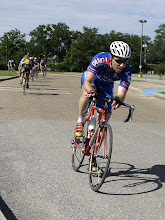Serotta Symposium Day 1
The reception last evening was very nice. Good food and lots of conversation. It was nice to meet Ben Serotta. He's done a good job of surrounding himself with great minds and people who are passionate about the sport of cycling.
Day one was packed. This is not one of those seminars where you have 3-4 hours of classes in the morning and ski all afternoon. In fact, other that going outside to take a few photos, I've been inside for classes during daylight hours.
Yesterday's presentations focused on pedaling dynamics and the role of muscular and non-muscular forces that affect the pedal stroke. It was very intersesting to see the differences between single leg readings and bilateral leg readings. The computrainer looks at both legs combined. Dr. Brooker's research uses a pair of $10,000 pedals that isolate one leg from another.
We covered Aerodynamics with Dr. Blair of MIT. He's incharge of the Wright Brothers Wind Tunnel. It was very interesting to gain an understanding of how a wind tunnel works. Overall however, his aerodynamic research is done in isolation. He doesn't take bike control, pedaling technique or comfort into consideration. On the flip side, when you are doing research at this level, you have to eliminate as many variables as possible to arrive at definatives for aerodynamics. If your interested, it costs $1000/hour. Pleaese let them know ahead of time because the power company needs a heads up before they start the moving wind in the tunnel. It pulls 2 megawatts of power.
We reviewed advanced technologies for bike fitting. Many of these technologies involved various forms of video analysis. Very impressive stuff. Here's what I took away from this lecture. "Only use technology when it can give you something that you can't otherwise percieve".
Most interesting was the pedal shoe interface discussion. As far as applicability, this was one of the best. Dr. Vogel looked at pedaling dynamics related to foot position. The discussion also took other things into consideration such as orthotics and wedges. I can really see an application for this for my clients but I will probably insert it into my analysis after I have trained my clients in the neuromuscular control aspects of pedaling. Just putting a wedge under the shoe or using an orthotic will not correct neuromuscular problems. They have to be looked at hand in hand. In my case, my knee position has significantly changed over the last year. Not because of wedges or cleat position. It has changed because I have learned to pedal better through diligent practice.
Dr Testa presented on the use of power analysis. He used to be the team MD for Mapei and 7-11. He's a very impressive speaker. He talked about using power for periodic assessment of progress. He preferred assessing power at various levels of blood lactate. I have to review his information to determine the real world applicability for me and my clients.
We ended the day with a panel discussion that could have lasted all evening but we eventually had to go to dinner.
Great day with alot of information. I'm sure today will be more of the same.


1 Comments:
no skiing in the afternoon? dude you need to choose a better seminar. or skip something--thats why they hand out course material
Post a Comment
<< Home